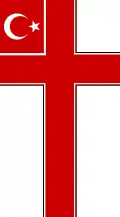Église orthodoxe turque
L'Église orthodoxe turque (en turc : Türk Ortodoks Kilisesi), Église orthodoxe turque karamanli, ou Patriarcat orthodoxe turc autocéphale (en turc : Bağımsız Türk Ortodoks Patrikhanesi), est une Église orthodoxe autocéphale. Le chef de l’Église porte le titre de Patriarche (en turc : Patrik) et réside à Istanbul.
| Patriarcat orthodoxe turc autocéphale (tr) Bağımsız Türk Ortodoks Patrikhanesi | |

| |
| Fondateur(s) | Pavli Eftim Karahisaroğlu Zeki Erenerol |
|---|---|
| Autocéphalie ou autonomie | |
| déclarée | 1922 |
| Reconnaissance | non reconnue |
| Primat actuel | Eftim IV |
Sous la République

Patriarcat orthodoxe turc indépendant. Plaque indiquant la présence du Patriarcat sur l'église Notre-Dame de Caffa d'Istanbul
Après la dislocation de l'URSS, le gouvernement turc proposa à Stepan Topal, alors leader des Gök-Oguz ou Gagaouzes (turcophones orthodoxes de Bessarabie), de se rattacher à Eftim III, qui serait ainsi passé d’une quarantaine de fidèles à près de 120 000[1].
Patriarches
- Papa Eftim I (1923-1964)
- Eftim II (1964-1991)
- Eftim III (1991-2002)
- Eftim IV (depuis 2002)
Notes et références
- « URSS : le rêve turc des Gagaouzes Effrayée par la Moldavie nationaliste, déçue par le Kremlin et méfiante à l'égard de la Roumanie, la jeune " République de Gagaouzie " se tourne vers Ankara », Le Monde.fr, (lire en ligne, consulté le )
Voir aussi
Articles connexes
Bibliographie complémentaire
- Xavier Luffin, Le long voyage d’Ashik Garip (traduit du karamanlica), Paris, L’Harmattan, 2005 (73 p.).
- Xavier Luffin, « Une version karamanlı d’Âşık Garip Hikâyesi : héros musulmans et public chrétien », in Talon, Ph. (ed), Recueil d’articles en hommage au Professeur Finet, Louvain, Peeters, 2005, p. 107-114.
- Xavier Luffin, « A Comparison between the English Bible Society’s Translations of the New Testament in Karamanlica (1892) and in Ottoman Turkish (1899) : the Choice of the Religious Vocabulary ». First soundings, The Journal of Eastern Christian Studies, 54, Nimègue, 2002, p. 149-162.
- Xavier Luffin, « Le Patriarcat orthodoxe turc », Het Christelijk Oosten, 52, Nimègue, 2000, p. 73-96.
- Xavier Luffin, « Une version karamanli de l’épopée de Köroglu », Archivum Ottomanicum, 16, Wiesbaden, 1998 (éditeur G. Hazai), p. 5-99.
- Xavier Luffin, « Baba Eftim et l'Église orthodoxe turque - De l'usage politique d'une institution religieuse », Journal of Eastern Christian Studies, Volume 52, issue 1-2, 2000. Compte-rendu in Journal of Eastern Christian Studies.
- Dr. Bestami Sadi Bilgic, « The Greek Orthodox Patriarchate and the Turkish-Greek Relations, 1923-1940 », Turkish Week, June 15, 2005 (pour l'épisode de l'occupation du Phanar).
- Melton, J. Gordon (éditeur). The Encyclopedia of American Religions, vol. 1. Tarrytown, NY: Triumph Books (1991), p. 135. (à propos de la branche américaine).
- Xavier, J. (1970/1971). « An Autocephalus Turkish Orthodox Church ». Eastern Church Review 3.
- Harry J. Psomiades, « The Ecumenical Patriarchate Under the Turkish Republic: The First Ten Years », Balkan Studies 2, Thessalonique, 1961, pp. 47-70.
- Richard Clogg, « The empty spaces where Greeks once were », The Times, November 30, 2005
Cet article est issu de wikipedia. Text licence: CC BY-SA 4.0, Des conditions supplémentaires peuvent s’appliquer aux fichiers multimédias.